Cross-Cultural Communication Strategies for International Business
VerifiedAdded on 2023/03/31
|8
|1687
|435
Essay
AI Summary
This essay delves into the multifaceted realm of cross-cultural communication, crucial for success in today's globalized business environment. It defines cross-cultural communication and highlights significant barriers such as stereotyping, language differences, ethnocentrism, and differing norms. The essay proposes practical solutions, including cross-cultural knowledge training, language training, and the implementation of mutual benefit policies. It explores influential theories like Edward Hall's high-context versus low-context communication and Hofstede's cultural dimensions, providing insights into managing cultural disparities. The analysis extends to the application of cross-cultural communication within international business organizations, emphasizing the importance of a 'we-oriented' approach and intercultural awareness. The conclusion underscores the need for an integrated approach, recognizing the limitations of single frameworks and advocating for comprehensive employee training to navigate the complexities of cross-cultural interactions in business, particularly within the context of the UAE.
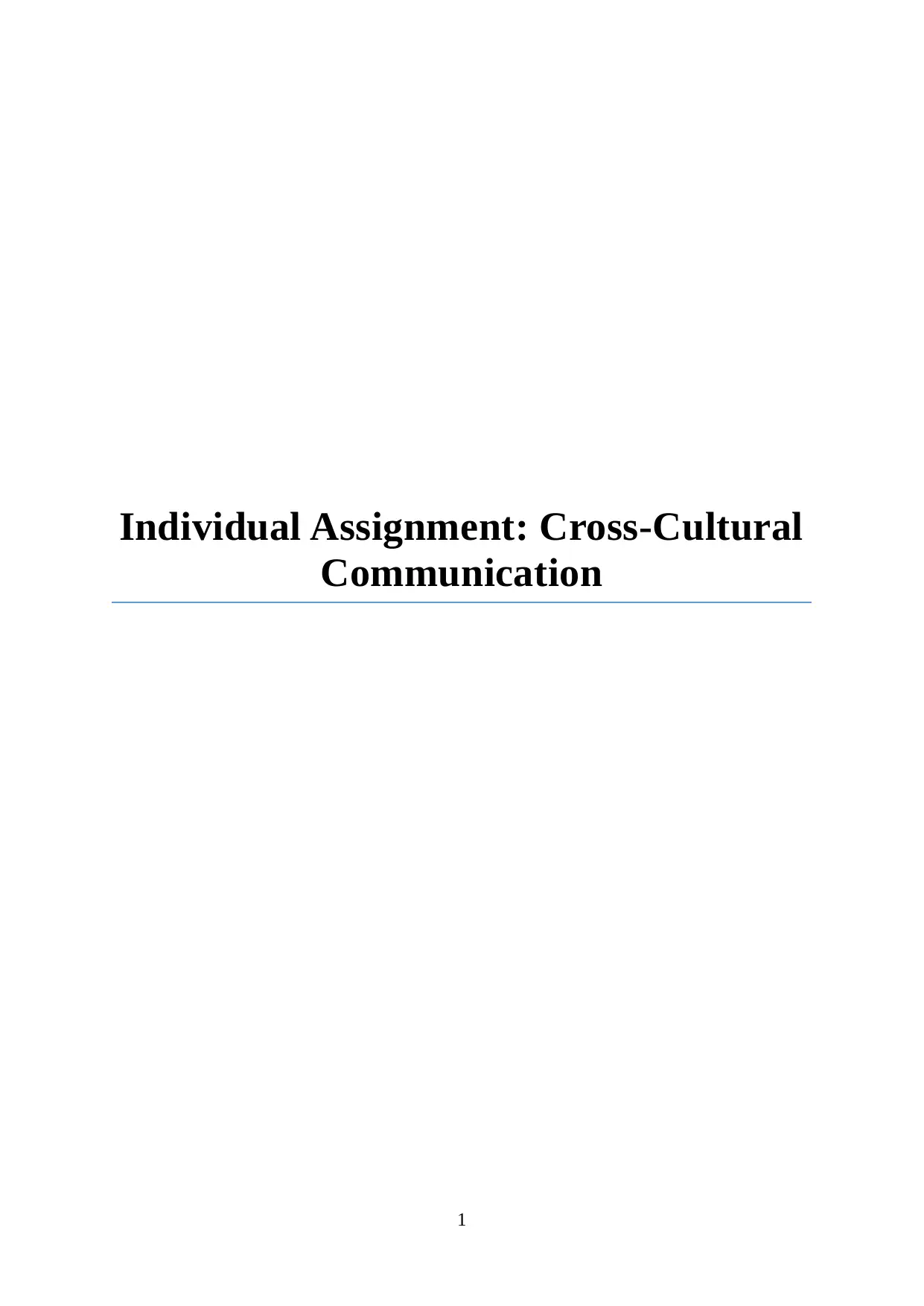
Individual Assignment: Cross-Cultural
Communication
1
Communication
1
Paraphrase This Document
Need a fresh take? Get an instant paraphrase of this document with our AI Paraphraser
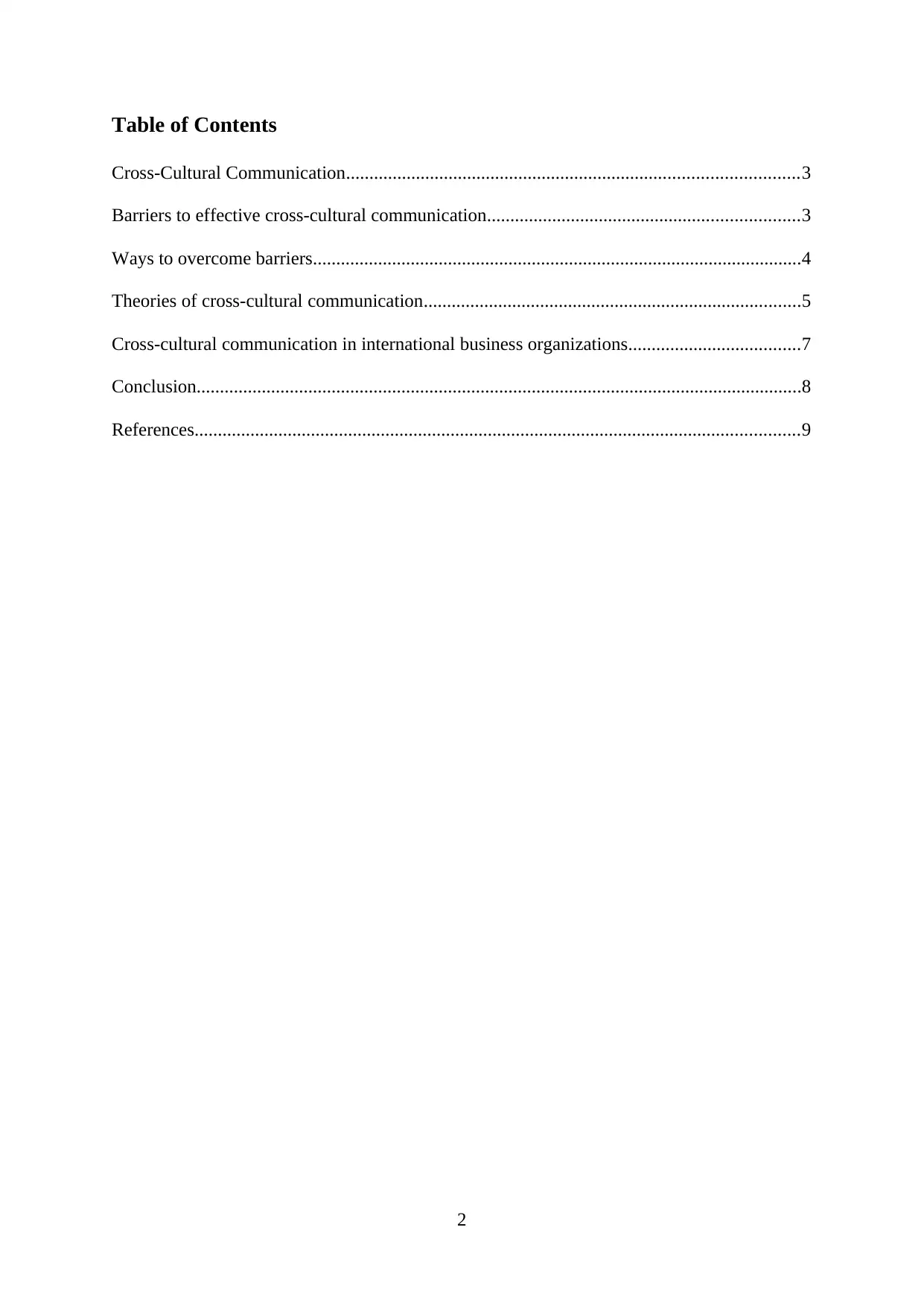
Table of Contents
Cross-Cultural Communication.................................................................................................3
Barriers to effective cross-cultural communication...................................................................3
Ways to overcome barriers.........................................................................................................4
Theories of cross-cultural communication.................................................................................5
Cross-cultural communication in international business organizations.....................................7
Conclusion..................................................................................................................................8
References..................................................................................................................................9
2
Cross-Cultural Communication.................................................................................................3
Barriers to effective cross-cultural communication...................................................................3
Ways to overcome barriers.........................................................................................................4
Theories of cross-cultural communication.................................................................................5
Cross-cultural communication in international business organizations.....................................7
Conclusion..................................................................................................................................8
References..................................................................................................................................9
2
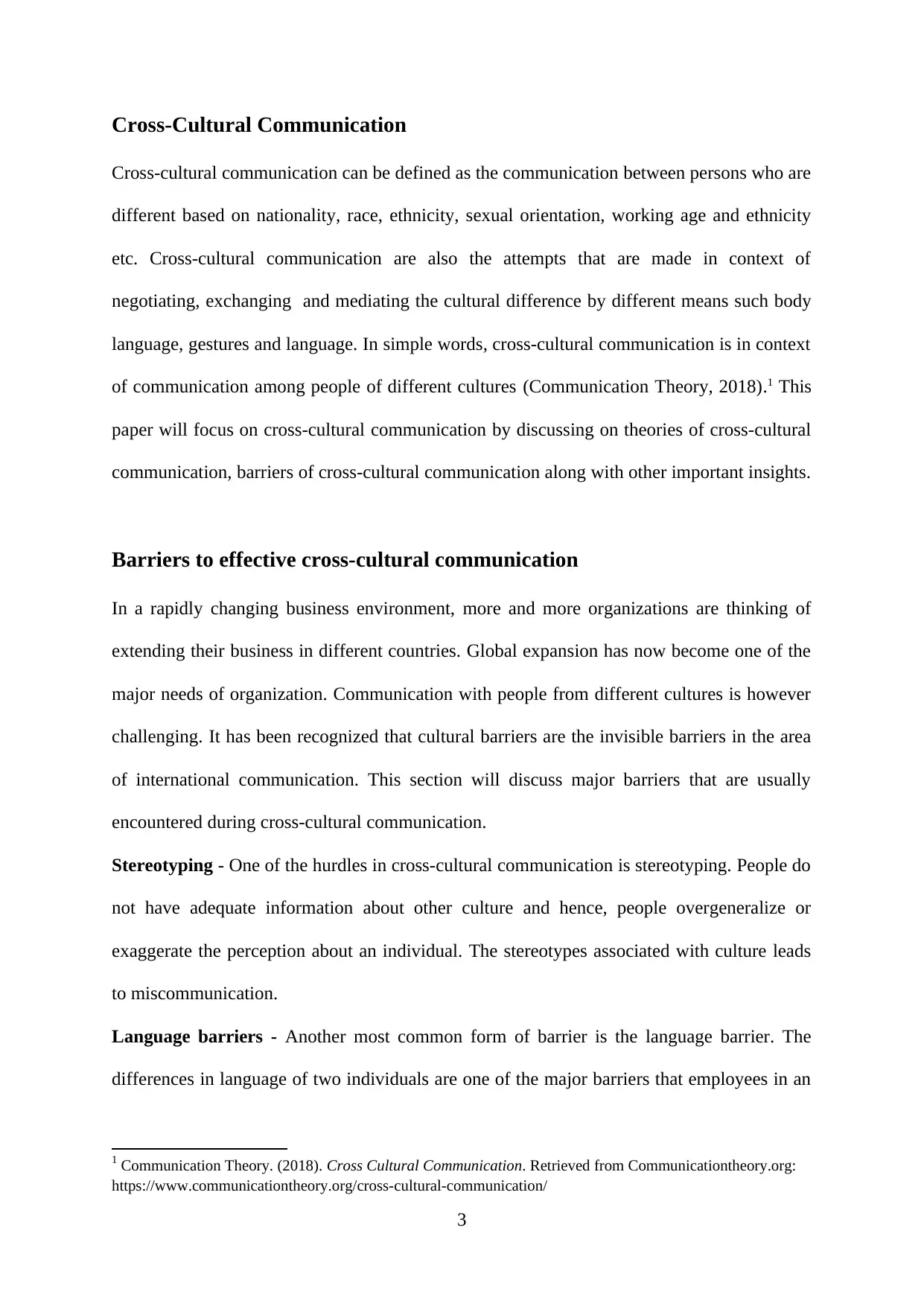
Cross-Cultural Communication
Cross-cultural communication can be defined as the communication between persons who are
different based on nationality, race, ethnicity, sexual orientation, working age and ethnicity
etc. Cross-cultural communication are also the attempts that are made in context of
negotiating, exchanging and mediating the cultural difference by different means such body
language, gestures and language. In simple words, cross-cultural communication is in context
of communication among people of different cultures (Communication Theory, 2018).1 This
paper will focus on cross-cultural communication by discussing on theories of cross-cultural
communication, barriers of cross-cultural communication along with other important insights.
Barriers to effective cross-cultural communication
In a rapidly changing business environment, more and more organizations are thinking of
extending their business in different countries. Global expansion has now become one of the
major needs of organization. Communication with people from different cultures is however
challenging. It has been recognized that cultural barriers are the invisible barriers in the area
of international communication. This section will discuss major barriers that are usually
encountered during cross-cultural communication.
Stereotyping - One of the hurdles in cross-cultural communication is stereotyping. People do
not have adequate information about other culture and hence, people overgeneralize or
exaggerate the perception about an individual. The stereotypes associated with culture leads
to miscommunication.
Language barriers - Another most common form of barrier is the language barrier. The
differences in language of two individuals are one of the major barriers that employees in an
1 Communication Theory. (2018). Cross Cultural Communication. Retrieved from Communicationtheory.org:
https://www.communicationtheory.org/cross-cultural-communication/
3
Cross-cultural communication can be defined as the communication between persons who are
different based on nationality, race, ethnicity, sexual orientation, working age and ethnicity
etc. Cross-cultural communication are also the attempts that are made in context of
negotiating, exchanging and mediating the cultural difference by different means such body
language, gestures and language. In simple words, cross-cultural communication is in context
of communication among people of different cultures (Communication Theory, 2018).1 This
paper will focus on cross-cultural communication by discussing on theories of cross-cultural
communication, barriers of cross-cultural communication along with other important insights.
Barriers to effective cross-cultural communication
In a rapidly changing business environment, more and more organizations are thinking of
extending their business in different countries. Global expansion has now become one of the
major needs of organization. Communication with people from different cultures is however
challenging. It has been recognized that cultural barriers are the invisible barriers in the area
of international communication. This section will discuss major barriers that are usually
encountered during cross-cultural communication.
Stereotyping - One of the hurdles in cross-cultural communication is stereotyping. People do
not have adequate information about other culture and hence, people overgeneralize or
exaggerate the perception about an individual. The stereotypes associated with culture leads
to miscommunication.
Language barriers - Another most common form of barrier is the language barrier. The
differences in language of two individuals are one of the major barriers that employees in an
1 Communication Theory. (2018). Cross Cultural Communication. Retrieved from Communicationtheory.org:
https://www.communicationtheory.org/cross-cultural-communication/
3
⊘ This is a preview!⊘
Do you want full access?
Subscribe today to unlock all pages.

Trusted by 1+ million students worldwide
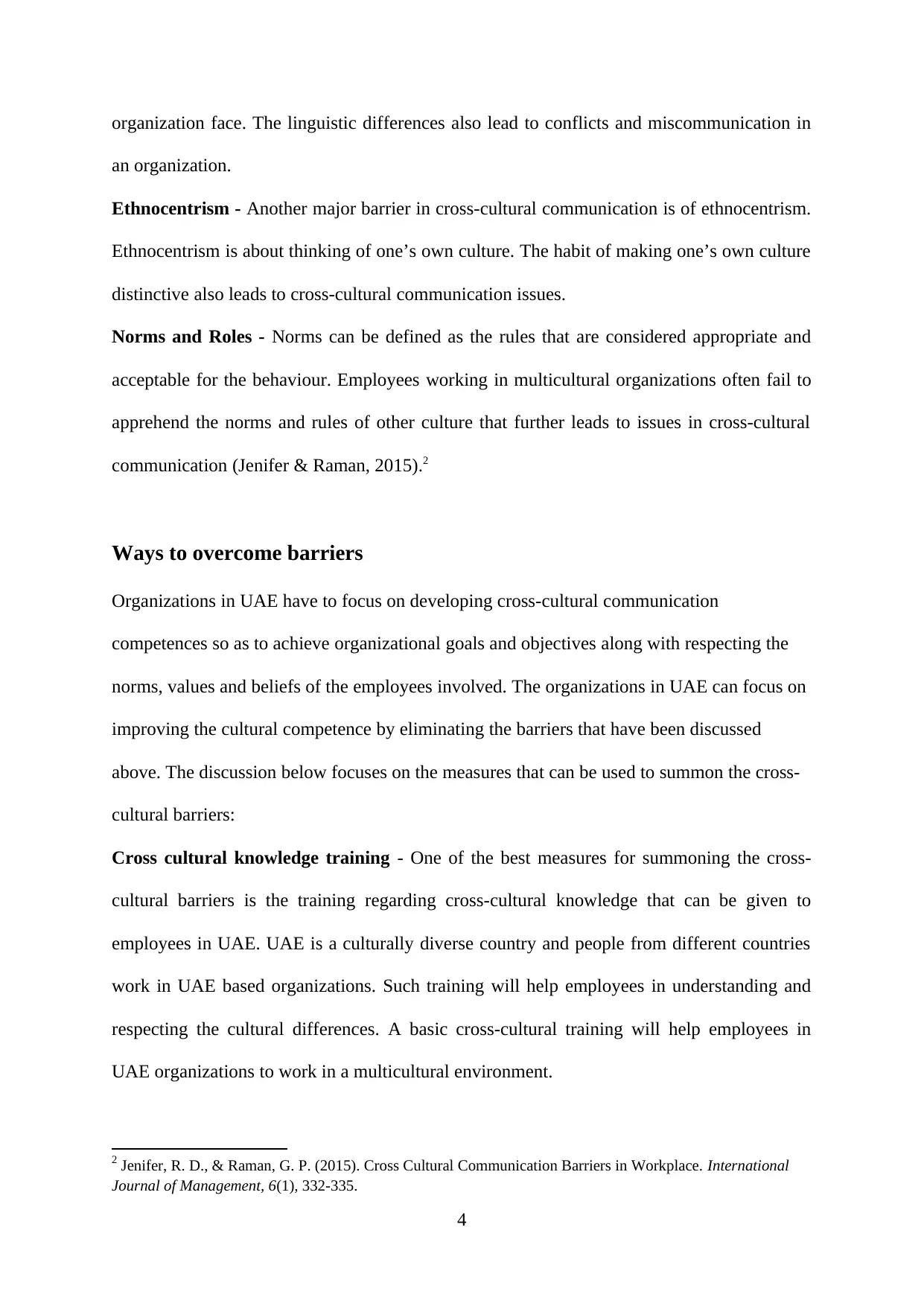
organization face. The linguistic differences also lead to conflicts and miscommunication in
an organization.
Ethnocentrism - Another major barrier in cross-cultural communication is of ethnocentrism.
Ethnocentrism is about thinking of one’s own culture. The habit of making one’s own culture
distinctive also leads to cross-cultural communication issues.
Norms and Roles - Norms can be defined as the rules that are considered appropriate and
acceptable for the behaviour. Employees working in multicultural organizations often fail to
apprehend the norms and rules of other culture that further leads to issues in cross-cultural
communication (Jenifer & Raman, 2015).2
Ways to overcome barriers
Organizations in UAE have to focus on developing cross-cultural communication
competences so as to achieve organizational goals and objectives along with respecting the
norms, values and beliefs of the employees involved. The organizations in UAE can focus on
improving the cultural competence by eliminating the barriers that have been discussed
above. The discussion below focuses on the measures that can be used to summon the cross-
cultural barriers:
Cross cultural knowledge training - One of the best measures for summoning the cross-
cultural barriers is the training regarding cross-cultural knowledge that can be given to
employees in UAE. UAE is a culturally diverse country and people from different countries
work in UAE based organizations. Such training will help employees in understanding and
respecting the cultural differences. A basic cross-cultural training will help employees in
UAE organizations to work in a multicultural environment.
2 Jenifer, R. D., & Raman, G. P. (2015). Cross Cultural Communication Barriers in Workplace. International
Journal of Management, 6(1), 332-335.
4
an organization.
Ethnocentrism - Another major barrier in cross-cultural communication is of ethnocentrism.
Ethnocentrism is about thinking of one’s own culture. The habit of making one’s own culture
distinctive also leads to cross-cultural communication issues.
Norms and Roles - Norms can be defined as the rules that are considered appropriate and
acceptable for the behaviour. Employees working in multicultural organizations often fail to
apprehend the norms and rules of other culture that further leads to issues in cross-cultural
communication (Jenifer & Raman, 2015).2
Ways to overcome barriers
Organizations in UAE have to focus on developing cross-cultural communication
competences so as to achieve organizational goals and objectives along with respecting the
norms, values and beliefs of the employees involved. The organizations in UAE can focus on
improving the cultural competence by eliminating the barriers that have been discussed
above. The discussion below focuses on the measures that can be used to summon the cross-
cultural barriers:
Cross cultural knowledge training - One of the best measures for summoning the cross-
cultural barriers is the training regarding cross-cultural knowledge that can be given to
employees in UAE. UAE is a culturally diverse country and people from different countries
work in UAE based organizations. Such training will help employees in understanding and
respecting the cultural differences. A basic cross-cultural training will help employees in
UAE organizations to work in a multicultural environment.
2 Jenifer, R. D., & Raman, G. P. (2015). Cross Cultural Communication Barriers in Workplace. International
Journal of Management, 6(1), 332-335.
4
Paraphrase This Document
Need a fresh take? Get an instant paraphrase of this document with our AI Paraphraser
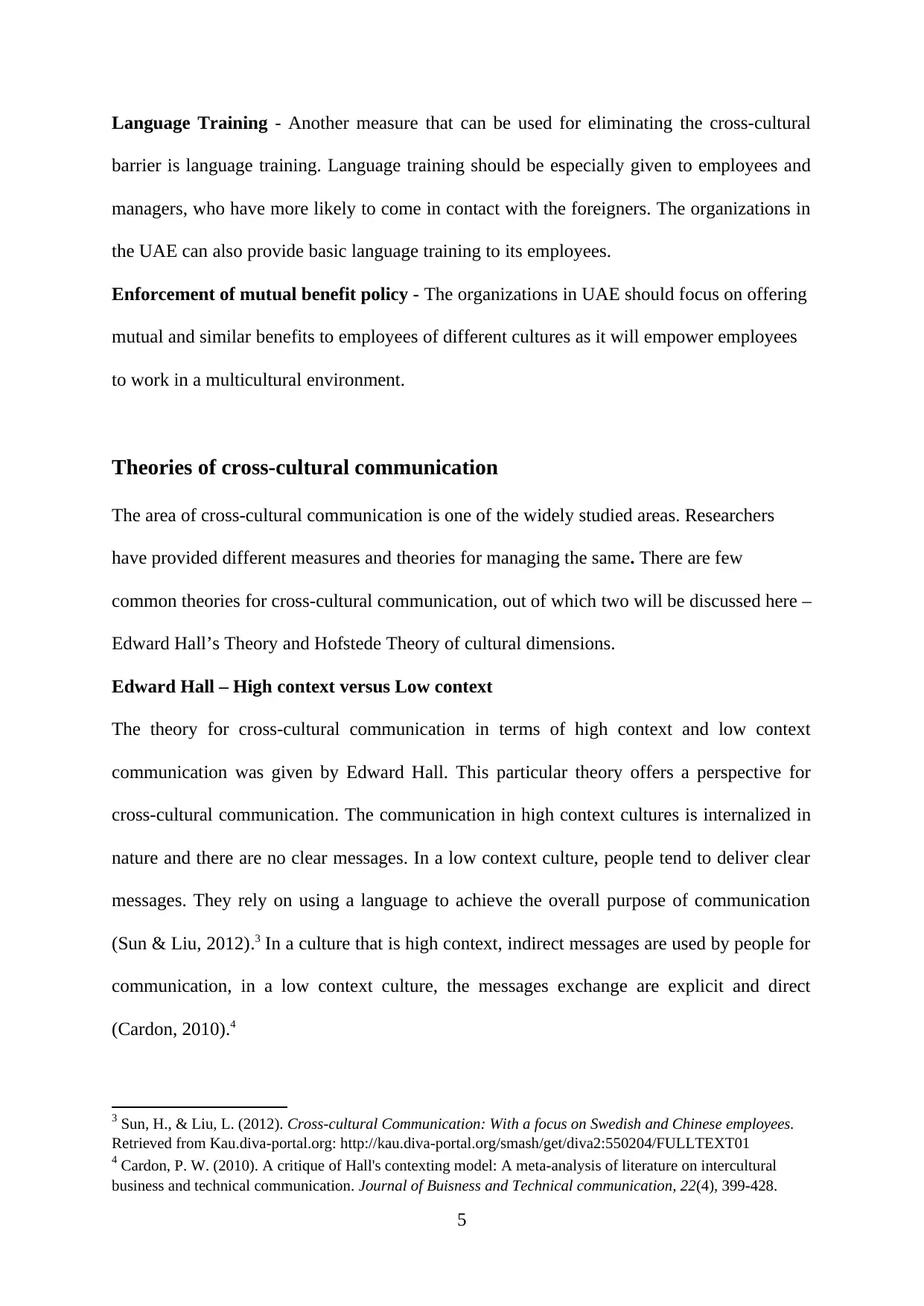
Language Training - Another measure that can be used for eliminating the cross-cultural
barrier is language training. Language training should be especially given to employees and
managers, who have more likely to come in contact with the foreigners. The organizations in
the UAE can also provide basic language training to its employees.
Enforcement of mutual benefit policy - The organizations in UAE should focus on offering
mutual and similar benefits to employees of different cultures as it will empower employees
to work in a multicultural environment.
Theories of cross-cultural communication
The area of cross-cultural communication is one of the widely studied areas. Researchers
have provided different measures and theories for managing the same. There are few
common theories for cross-cultural communication, out of which two will be discussed here –
Edward Hall’s Theory and Hofstede Theory of cultural dimensions.
Edward Hall – High context versus Low context
The theory for cross-cultural communication in terms of high context and low context
communication was given by Edward Hall. This particular theory offers a perspective for
cross-cultural communication. The communication in high context cultures is internalized in
nature and there are no clear messages. In a low context culture, people tend to deliver clear
messages. They rely on using a language to achieve the overall purpose of communication
(Sun & Liu, 2012).3 In a culture that is high context, indirect messages are used by people for
communication, in a low context culture, the messages exchange are explicit and direct
(Cardon, 2010).4
3 Sun, H., & Liu, L. (2012). Cross-cultural Communication: With a focus on Swedish and Chinese employees.
Retrieved from Kau.diva-portal.org: http://kau.diva-portal.org/smash/get/diva2:550204/FULLTEXT01
4 Cardon, P. W. (2010). A critique of Hall's contexting model: A meta-analysis of literature on intercultural
business and technical communication. Journal of Buisness and Technical communication, 22(4), 399-428.
5
barrier is language training. Language training should be especially given to employees and
managers, who have more likely to come in contact with the foreigners. The organizations in
the UAE can also provide basic language training to its employees.
Enforcement of mutual benefit policy - The organizations in UAE should focus on offering
mutual and similar benefits to employees of different cultures as it will empower employees
to work in a multicultural environment.
Theories of cross-cultural communication
The area of cross-cultural communication is one of the widely studied areas. Researchers
have provided different measures and theories for managing the same. There are few
common theories for cross-cultural communication, out of which two will be discussed here –
Edward Hall’s Theory and Hofstede Theory of cultural dimensions.
Edward Hall – High context versus Low context
The theory for cross-cultural communication in terms of high context and low context
communication was given by Edward Hall. This particular theory offers a perspective for
cross-cultural communication. The communication in high context cultures is internalized in
nature and there are no clear messages. In a low context culture, people tend to deliver clear
messages. They rely on using a language to achieve the overall purpose of communication
(Sun & Liu, 2012).3 In a culture that is high context, indirect messages are used by people for
communication, in a low context culture, the messages exchange are explicit and direct
(Cardon, 2010).4
3 Sun, H., & Liu, L. (2012). Cross-cultural Communication: With a focus on Swedish and Chinese employees.
Retrieved from Kau.diva-portal.org: http://kau.diva-portal.org/smash/get/diva2:550204/FULLTEXT01
4 Cardon, P. W. (2010). A critique of Hall's contexting model: A meta-analysis of literature on intercultural
business and technical communication. Journal of Buisness and Technical communication, 22(4), 399-428.
5
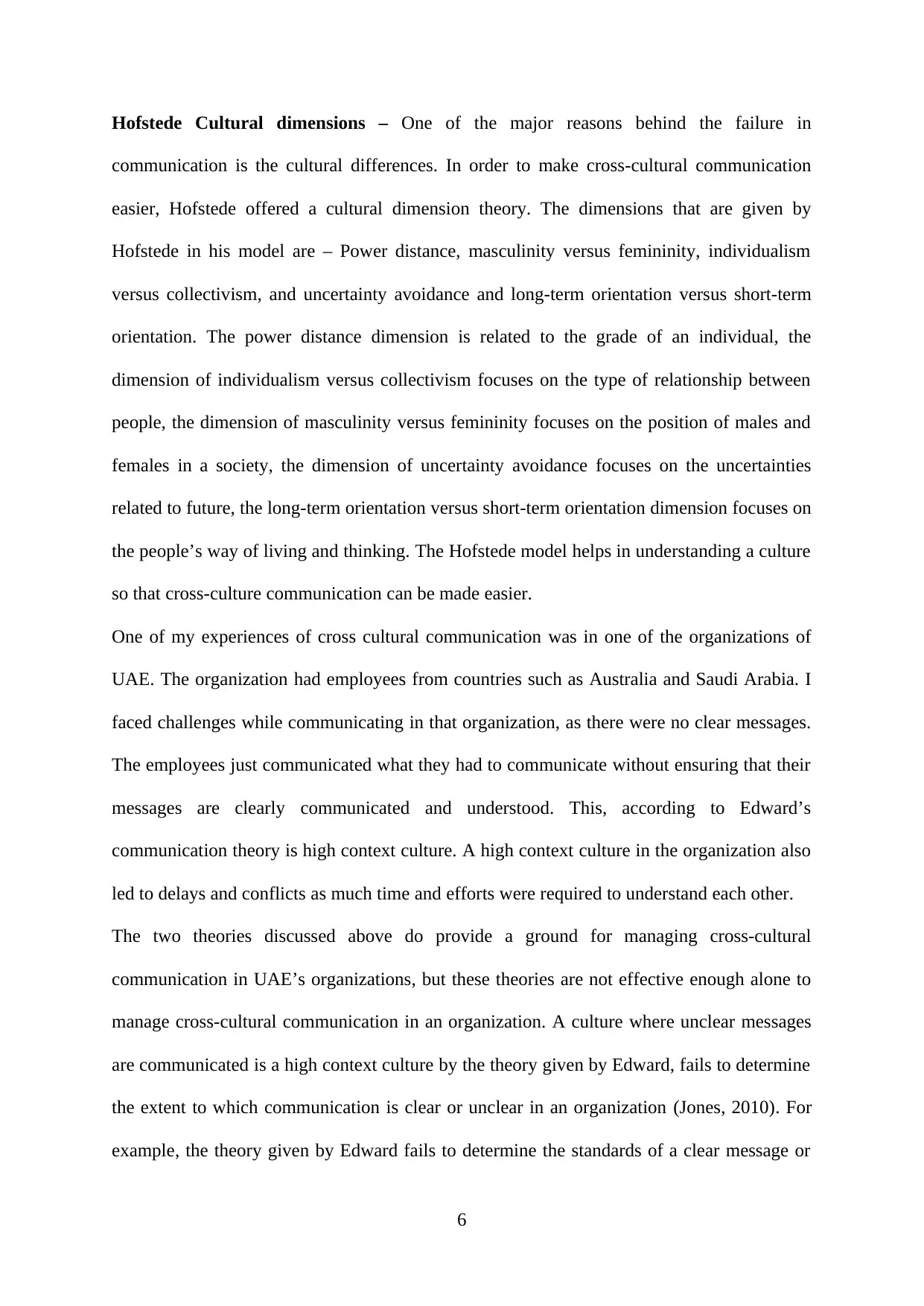
Hofstede Cultural dimensions – One of the major reasons behind the failure in
communication is the cultural differences. In order to make cross-cultural communication
easier, Hofstede offered a cultural dimension theory. The dimensions that are given by
Hofstede in his model are – Power distance, masculinity versus femininity, individualism
versus collectivism, and uncertainty avoidance and long-term orientation versus short-term
orientation. The power distance dimension is related to the grade of an individual, the
dimension of individualism versus collectivism focuses on the type of relationship between
people, the dimension of masculinity versus femininity focuses on the position of males and
females in a society, the dimension of uncertainty avoidance focuses on the uncertainties
related to future, the long-term orientation versus short-term orientation dimension focuses on
the people’s way of living and thinking. The Hofstede model helps in understanding a culture
so that cross-culture communication can be made easier.
One of my experiences of cross cultural communication was in one of the organizations of
UAE. The organization had employees from countries such as Australia and Saudi Arabia. I
faced challenges while communicating in that organization, as there were no clear messages.
The employees just communicated what they had to communicate without ensuring that their
messages are clearly communicated and understood. This, according to Edward’s
communication theory is high context culture. A high context culture in the organization also
led to delays and conflicts as much time and efforts were required to understand each other.
The two theories discussed above do provide a ground for managing cross-cultural
communication in UAE’s organizations, but these theories are not effective enough alone to
manage cross-cultural communication in an organization. A culture where unclear messages
are communicated is a high context culture by the theory given by Edward, fails to determine
the extent to which communication is clear or unclear in an organization (Jones, 2010). For
example, the theory given by Edward fails to determine the standards of a clear message or
6
communication is the cultural differences. In order to make cross-cultural communication
easier, Hofstede offered a cultural dimension theory. The dimensions that are given by
Hofstede in his model are – Power distance, masculinity versus femininity, individualism
versus collectivism, and uncertainty avoidance and long-term orientation versus short-term
orientation. The power distance dimension is related to the grade of an individual, the
dimension of individualism versus collectivism focuses on the type of relationship between
people, the dimension of masculinity versus femininity focuses on the position of males and
females in a society, the dimension of uncertainty avoidance focuses on the uncertainties
related to future, the long-term orientation versus short-term orientation dimension focuses on
the people’s way of living and thinking. The Hofstede model helps in understanding a culture
so that cross-culture communication can be made easier.
One of my experiences of cross cultural communication was in one of the organizations of
UAE. The organization had employees from countries such as Australia and Saudi Arabia. I
faced challenges while communicating in that organization, as there were no clear messages.
The employees just communicated what they had to communicate without ensuring that their
messages are clearly communicated and understood. This, according to Edward’s
communication theory is high context culture. A high context culture in the organization also
led to delays and conflicts as much time and efforts were required to understand each other.
The two theories discussed above do provide a ground for managing cross-cultural
communication in UAE’s organizations, but these theories are not effective enough alone to
manage cross-cultural communication in an organization. A culture where unclear messages
are communicated is a high context culture by the theory given by Edward, fails to determine
the extent to which communication is clear or unclear in an organization (Jones, 2010). For
example, the theory given by Edward fails to determine the standards of a clear message or
6
⊘ This is a preview!⊘
Do you want full access?
Subscribe today to unlock all pages.

Trusted by 1+ million students worldwide
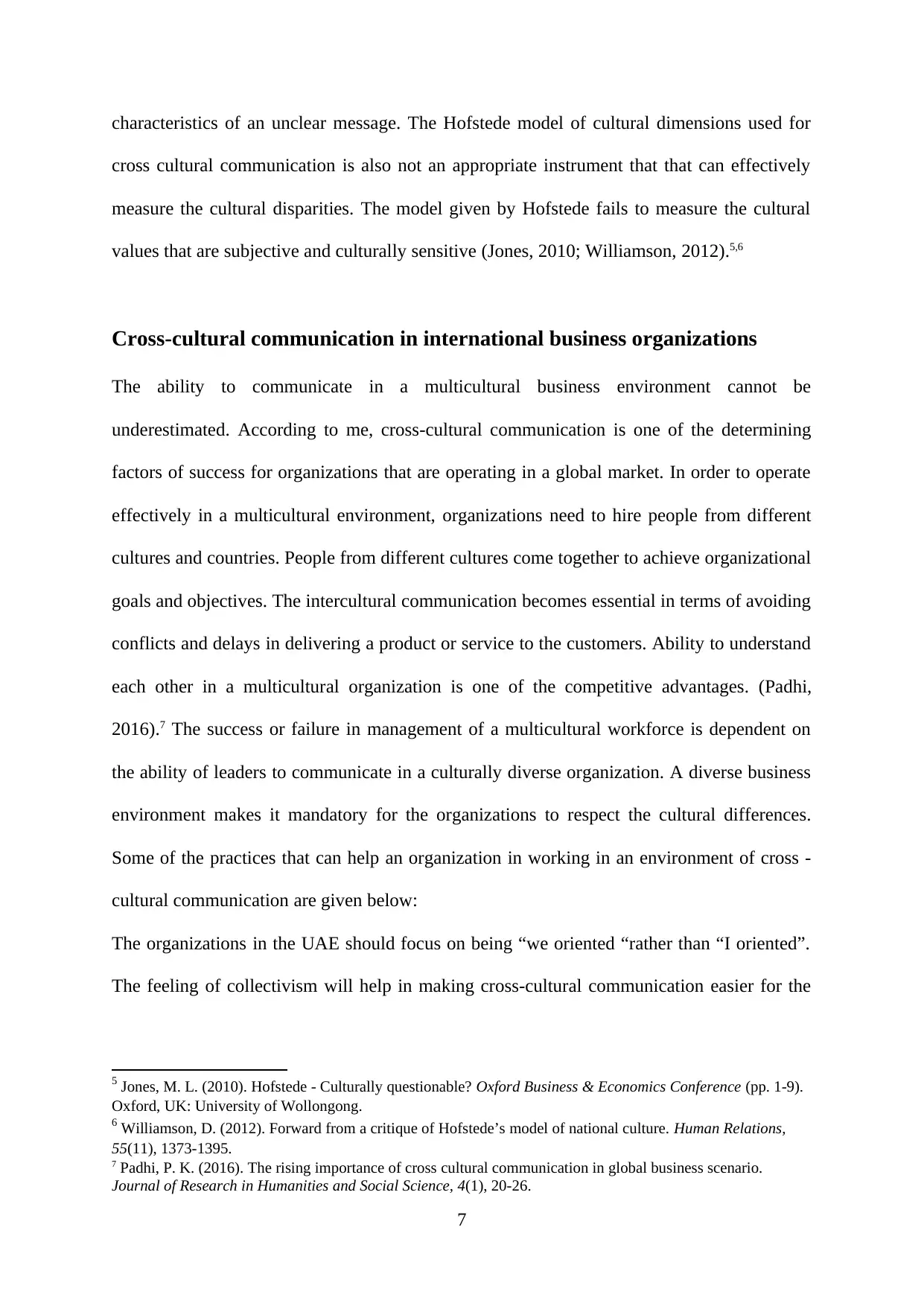
characteristics of an unclear message. The Hofstede model of cultural dimensions used for
cross cultural communication is also not an appropriate instrument that that can effectively
measure the cultural disparities. The model given by Hofstede fails to measure the cultural
values that are subjective and culturally sensitive (Jones, 2010; Williamson, 2012).5,6
Cross-cultural communication in international business organizations
The ability to communicate in a multicultural business environment cannot be
underestimated. According to me, cross-cultural communication is one of the determining
factors of success for organizations that are operating in a global market. In order to operate
effectively in a multicultural environment, organizations need to hire people from different
cultures and countries. People from different cultures come together to achieve organizational
goals and objectives. The intercultural communication becomes essential in terms of avoiding
conflicts and delays in delivering a product or service to the customers. Ability to understand
each other in a multicultural organization is one of the competitive advantages. (Padhi,
2016).7 The success or failure in management of a multicultural workforce is dependent on
the ability of leaders to communicate in a culturally diverse organization. A diverse business
environment makes it mandatory for the organizations to respect the cultural differences.
Some of the practices that can help an organization in working in an environment of cross -
cultural communication are given below:
The organizations in the UAE should focus on being “we oriented “rather than “I oriented”.
The feeling of collectivism will help in making cross-cultural communication easier for the
5 Jones, M. L. (2010). Hofstede - Culturally questionable? Oxford Business & Economics Conference (pp. 1-9).
Oxford, UK: University of Wollongong.
6 Williamson, D. (2012). Forward from a critique of Hofstede’s model of national culture. Human Relations,
55(11), 1373-1395.
7 Padhi, P. K. (2016). The rising importance of cross cultural communication in global business scenario.
Journal of Research in Humanities and Social Science, 4(1), 20-26.
7
cross cultural communication is also not an appropriate instrument that that can effectively
measure the cultural disparities. The model given by Hofstede fails to measure the cultural
values that are subjective and culturally sensitive (Jones, 2010; Williamson, 2012).5,6
Cross-cultural communication in international business organizations
The ability to communicate in a multicultural business environment cannot be
underestimated. According to me, cross-cultural communication is one of the determining
factors of success for organizations that are operating in a global market. In order to operate
effectively in a multicultural environment, organizations need to hire people from different
cultures and countries. People from different cultures come together to achieve organizational
goals and objectives. The intercultural communication becomes essential in terms of avoiding
conflicts and delays in delivering a product or service to the customers. Ability to understand
each other in a multicultural organization is one of the competitive advantages. (Padhi,
2016).7 The success or failure in management of a multicultural workforce is dependent on
the ability of leaders to communicate in a culturally diverse organization. A diverse business
environment makes it mandatory for the organizations to respect the cultural differences.
Some of the practices that can help an organization in working in an environment of cross -
cultural communication are given below:
The organizations in the UAE should focus on being “we oriented “rather than “I oriented”.
The feeling of collectivism will help in making cross-cultural communication easier for the
5 Jones, M. L. (2010). Hofstede - Culturally questionable? Oxford Business & Economics Conference (pp. 1-9).
Oxford, UK: University of Wollongong.
6 Williamson, D. (2012). Forward from a critique of Hofstede’s model of national culture. Human Relations,
55(11), 1373-1395.
7 Padhi, P. K. (2016). The rising importance of cross cultural communication in global business scenario.
Journal of Research in Humanities and Social Science, 4(1), 20-26.
7
Paraphrase This Document
Need a fresh take? Get an instant paraphrase of this document with our AI Paraphraser
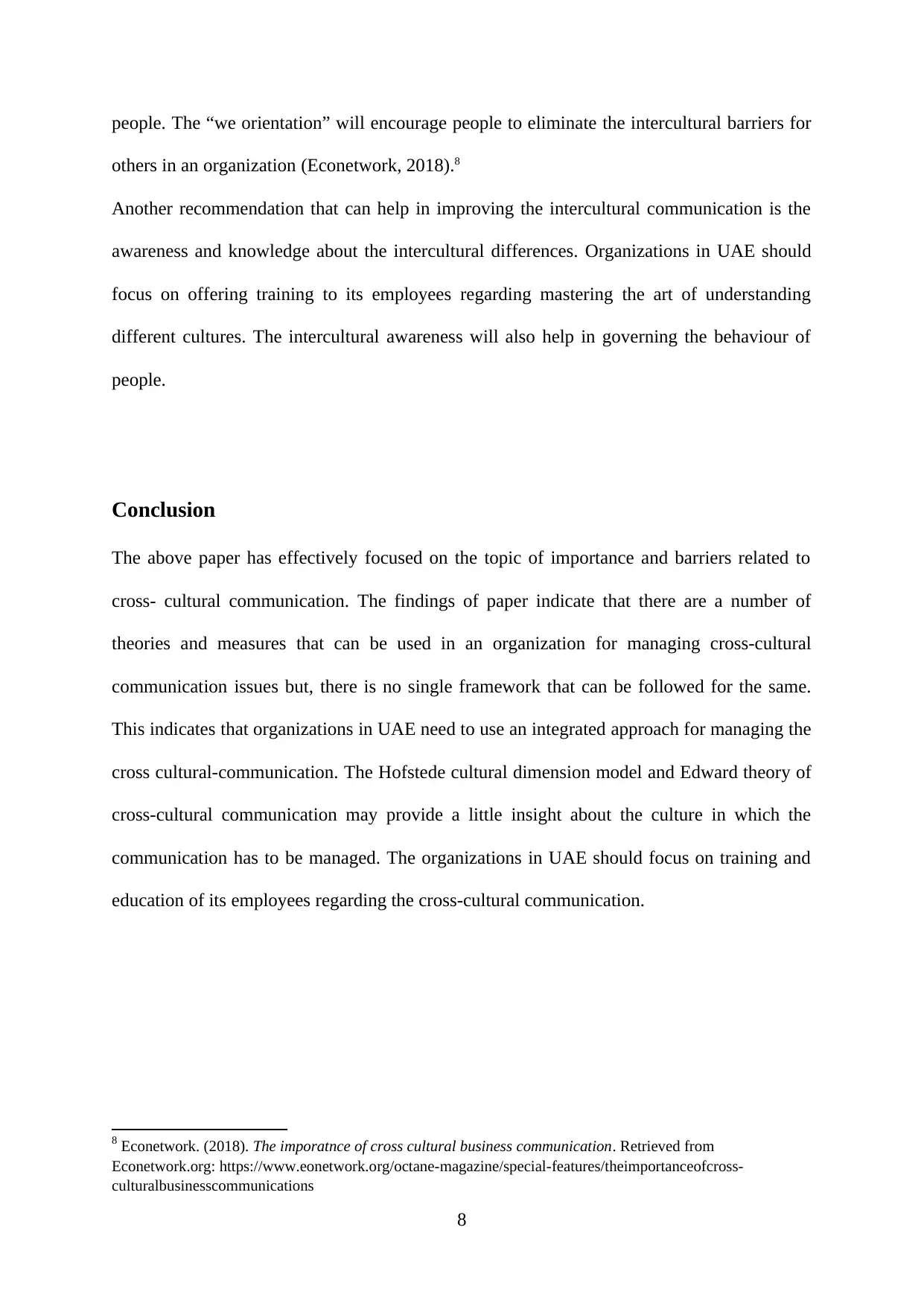
people. The “we orientation” will encourage people to eliminate the intercultural barriers for
others in an organization (Econetwork, 2018).8
Another recommendation that can help in improving the intercultural communication is the
awareness and knowledge about the intercultural differences. Organizations in UAE should
focus on offering training to its employees regarding mastering the art of understanding
different cultures. The intercultural awareness will also help in governing the behaviour of
people.
Conclusion
The above paper has effectively focused on the topic of importance and barriers related to
cross- cultural communication. The findings of paper indicate that there are a number of
theories and measures that can be used in an organization for managing cross-cultural
communication issues but, there is no single framework that can be followed for the same.
This indicates that organizations in UAE need to use an integrated approach for managing the
cross cultural-communication. The Hofstede cultural dimension model and Edward theory of
cross-cultural communication may provide a little insight about the culture in which the
communication has to be managed. The organizations in UAE should focus on training and
education of its employees regarding the cross-cultural communication.
8 Econetwork. (2018). The imporatnce of cross cultural business communication. Retrieved from
Econetwork.org: https://www.eonetwork.org/octane-magazine/special-features/theimportanceofcross-
culturalbusinesscommunications
8
others in an organization (Econetwork, 2018).8
Another recommendation that can help in improving the intercultural communication is the
awareness and knowledge about the intercultural differences. Organizations in UAE should
focus on offering training to its employees regarding mastering the art of understanding
different cultures. The intercultural awareness will also help in governing the behaviour of
people.
Conclusion
The above paper has effectively focused on the topic of importance and barriers related to
cross- cultural communication. The findings of paper indicate that there are a number of
theories and measures that can be used in an organization for managing cross-cultural
communication issues but, there is no single framework that can be followed for the same.
This indicates that organizations in UAE need to use an integrated approach for managing the
cross cultural-communication. The Hofstede cultural dimension model and Edward theory of
cross-cultural communication may provide a little insight about the culture in which the
communication has to be managed. The organizations in UAE should focus on training and
education of its employees regarding the cross-cultural communication.
8 Econetwork. (2018). The imporatnce of cross cultural business communication. Retrieved from
Econetwork.org: https://www.eonetwork.org/octane-magazine/special-features/theimportanceofcross-
culturalbusinesscommunications
8
1 out of 8
Related Documents
Your All-in-One AI-Powered Toolkit for Academic Success.
+13062052269
info@desklib.com
Available 24*7 on WhatsApp / Email
![[object Object]](/_next/static/media/star-bottom.7253800d.svg)
Unlock your academic potential
Copyright © 2020–2025 A2Z Services. All Rights Reserved. Developed and managed by ZUCOL.





